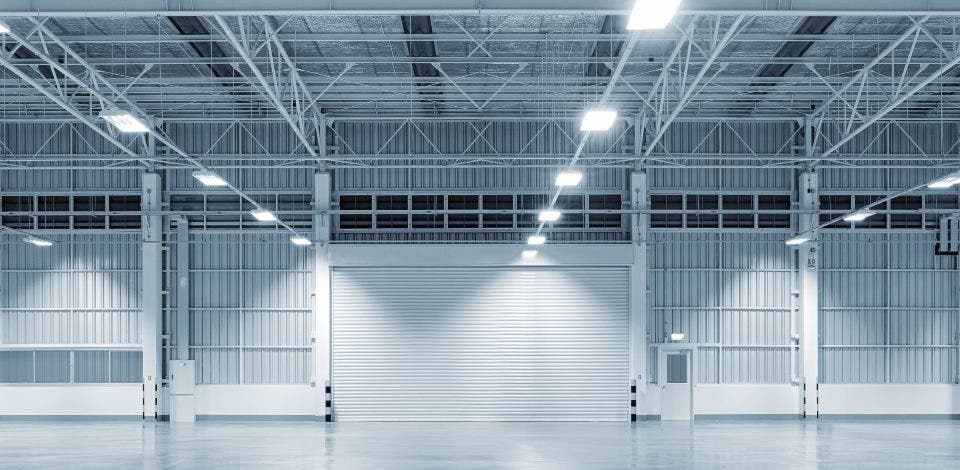Everything You Need to Know About Commercial LED Lighting

LED lighting is becoming increasingly popular in commercial spaces thanks to its cost-efficiency and longevity. Office spaces, factories, and other commercial spaces largely benefit from upgrading to LED lighting, however, upgrading the lighting for your business can leave you with a lot of important questions to be answered.
We’ve compiled some commonly asked questions to help explain the key benefits of adopting commercial LED lighting.
What Is Commercial Lighting?
As the name suggests, commercial lighting is specifically designed to illuminate commercial spaces such as restaurants, offices, churches, etc. Businesses using commercial lighting often prefer LED lights because they help reduce costs thanks to their energy efficiency.
Businesses typically use indoor LED lights to help reduce eye strain for employees while they work and provide safer working conditions overall. Outdoor LED lighting is used for entrances and exits signs and access doors. Commercial lighting differs from residential lighting in that it focuses on function over fashion, prioritizing appropriate light for working and safety.
Indoor LED lighting is preferred over traditional lighting because it lasts significantly longer, requiring fewer bulb changes and disruptions to the workplace. LED lights are also brighter than other types of lighting, such as fluorescent bulbs, and are not associated with causing migraine headaches like fluorescent lighting.
What Are The Types Of Commercial Lights?
There are several critical varieties of commercial lighting, and each type has its specific usage. To help determine which type of commercial lighting is best for your business, we’ve compiled a summarized overview of the most common varieties.
- LED Shop Lights - LED shop lights are designed to provide sufficient light for garages and other workspaces, and LED shop lights come in different lengths to suit space requirements.
- Wrap Lights - Wrap lights are mounted to the ceiling and provide strong light coverage.
- Strip Lights - Strip lights are often used for garages and home workshops as they are affordable and can have an adjustable color temperature.
- Troffers - Troffers are best used in spaces with dropped ceilings and require even spacing throughout a room. Troffers can be hard-wired and surface mounted to a ceiling or recessed into a ceiling. LED integrated lighting options can control the color output based on the lighting needs.
- High Bay Lights - High bay lights can use LED or fluorescent bulbs and are best suited for large spaces with high ceilings.
- Emergency and Exit Lighting - Emergency and exit lighting signs are needed in any commercial space. This type of lighting can be hard-wired or battery operated and are compatible with LED, incandescent, or halogen bulbs.
How Long Do Commercial Lights Last?
When it comes to lighting commercial spaces, there are three main light and bulb choices:
LED, incandescent, and fluorescent. Incandescent lights are traditional light bulbs with an average light lifespan of 1,000 hours, and fluorescent light bulbs are an improvement over incandescent bulbs with an average lifespan of about 9,000 hours. LED lighting is the preferred type for commercial spaces due to its significantly longer lifespan. The average LED light lasts an impressive 20,000-50,000 hours without being shut off. If the LED light is used 8 hours a day, it will last approximately 17 years.
What Are the Benefits of Commercial LED Lighting?
When it comes to commercial lighting, LED is considered the clear favorite for several key reasons:
Cost Savings
Although commercial LED lighting costs more than other lighting and bulbs, the long-term savings make them the most cost-efficient choice. LED lights use about 20% of an incandescent bulb's energy to produce light, saving money on utility bills. Businesses using LED lighting can also benefit from tax and utility company incentives.
Healthier Business Environments
Traditional incandescent bulbs contain toxins like mercury and chemicals known to be dangerous in long-term exposure. LED lights contain some chemicals and properties such as lead, but they do not contain mercury. LED bulbs are not considered toxic in the United States, so they can also be safely recycled.
Safer Spaces
In addition to their safer compounds, LED lights are also not credited with the same adverse health effects as incandescent bulbs. The flickering and noise caused by fluorescent lighting can be distracting and make employees feel uncomfortable and agitated. Also, fluorescent lights are known to cause severe headaches in some people.
Environmental Gains
LED lights are deemed recyclable in the U.S., making them an excellent choice for eco-conscious businesses. Additionally, LED lights use less energy and leave a smaller carbon footprint than businesses using traditional lighting.
Consumer Perception
Eco-conscious consumers support businesses whose values align with their own. The growing concerns around climate change and the catastrophic effects it causes have made sustainability a priority in most industries. Without sustainability initiatives, industries, especially those that use large amounts of energy, are negatively viewed by consumers. This disconnect between consumers and businesses can result in a loss of profits.
Is Commercial Lighting Right for Your Business?
Overall, LED commercial lighting will save your business money, reduce employee health issues like headaches, and earn your business some good PR for your use of eco-friendly lighting.
Industries such as manufacturing and auto repair are upgrading their lighting to LED to help improve the safety of their workers. LED lights are more durable than fluorescent or incandescent lights, making them less likely to shatter in an environment where accidents can occur. Bay lighting for both manufacturing and auto repair is often exposed to the elements, so you will want to ensure your lighting system is safe in all weather conditions.
LED lights are typically waterproof and unaffected by weather changes making them the increasingly popular choice in many industries.
Commercial LED lights are also increasing in popularity among the food production industries. Unlike traditional lighting, LED lighting can also be used in cold temperatures like commercial freezers or in large warehouses that aren’t adequately insulated during the winter. LED lights are considered the safer option for food production spaces since they are shatter-resistant and do not have dangerous chemicals like those found in traditional lighting.
What Are Some Features to Look for in Commercial LED Lighting?
When choosing commercial LED lighting for your business, you will want to consider a few key features:
Light Output
When selecting your LED lighting, you will need to know how much light output you need for your space; this measurement is called lumens. Lumens measure the brightness of a bulb, and traditional bulbs are measured by watts, which is the amount of energy used.
It’s important to know exactly how much light output is needed for your space before you begin purchasing any lighting. First, you’ll need to know the square footage of the area ( length x width in feet) and then use this lighting layout tool to determine what you need to light the space effectively.
Color Temperature
The most popular color temperature options are cool, daylight, and bright light—the lower the color temperature, the closer the lighting to traditional bulbs. Color temperature in light bulbs is measured using kelvins; the lower the kelvins, the more yellow the color.
Here’s a quick guide to popular color temperatures: Incandescent bulbs – 2500K to 3500K; Halogen lamps – 2700K to 3500K; Fluorescent lamps – 2700K to 6500K; LED lights – 2700K to 6500K. For commercial lighting, it’s recommended to use a product measuring around 4000K.
CRI (Color Rendering Index)
CRI refers to a light’s ability to accurately reveal the colors of an item compared to natural light. LED lights have a color rendering index range between 70-95. Commercial lighting in spaces like factories or auto shops requires color accuracy; therefore, the CRI index is recommended to be above 82.
If you’re purchasing a shop light system, the CRI information is located in the product description. The closer to 100, the better the CRI will be – over 90 is considered excellent.
Interested in commercial lighting opportunities? Look through our selection of Commercial LED Lighting and find the right match for your commercial needs!

